brake TOYOTA PRIUS C 2012 NHP10 / 1.G Quick Reference Guide
[x] Cancel search | Manufacturer: TOYOTA, Model Year: 2012, Model line: PRIUS C, Model: TOYOTA PRIUS C 2012 NHP10 / 1.GPages: 31, PDF Size: 1.11 MB
Page 3 of 31
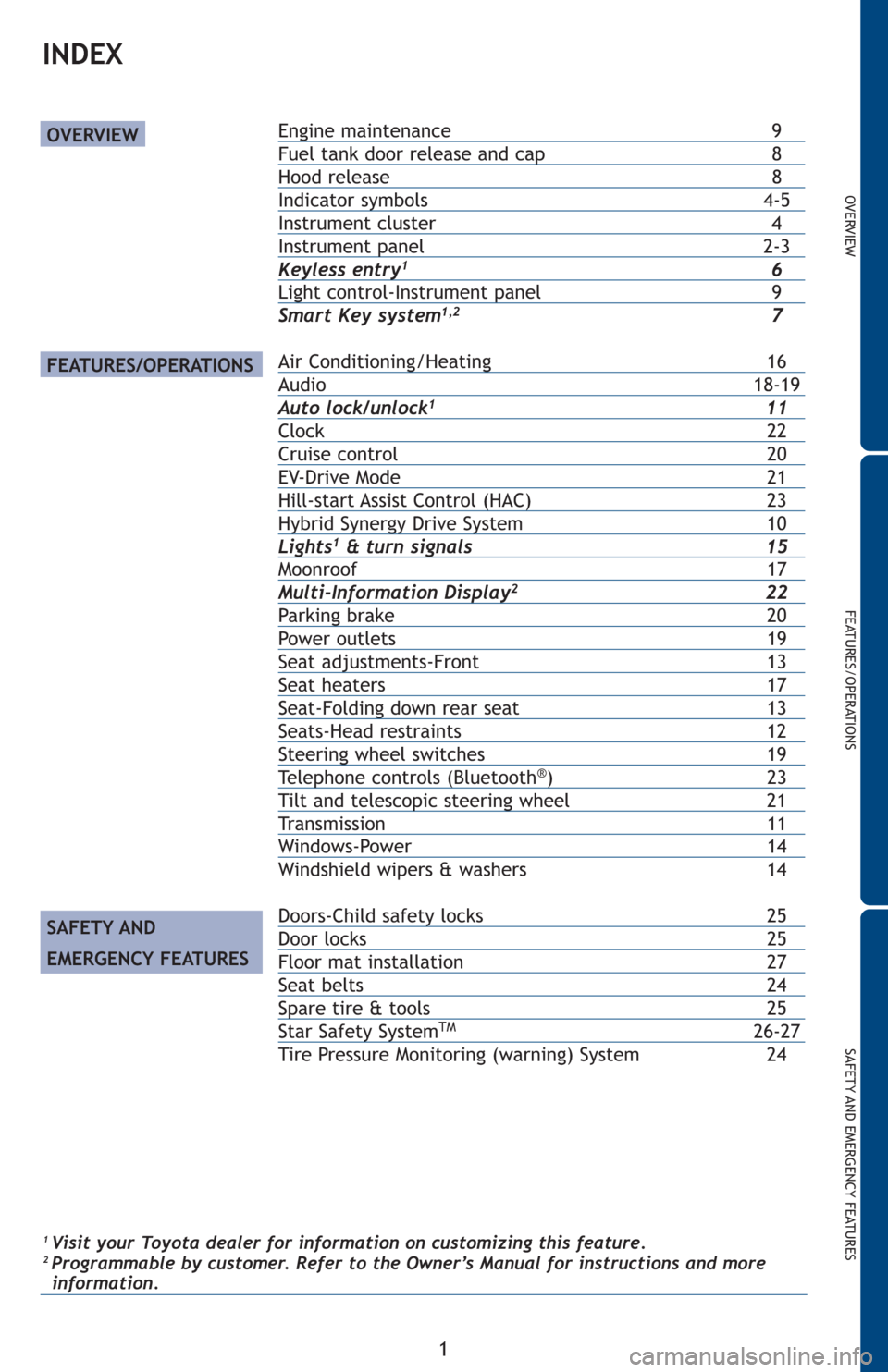
OVERVIEW
FEATURES/OPERATIONS
SAFETY AND EMERGENCY FEATURES
1
INDEX
OVERVIEW
FEATURES/OPERATIONS
SAFETY AND
EMERGENCY FEATURES
Engine maintenance 9
Fuel tank door release and cap 8
Hood release 8
Indicator symbols 4-5
Instrument cluster 4
Instrument panel 2-3
Keyless entry16
Light control-Instrument panel 9
Smart Key system1,27
Air Conditioning/Heating 16
Audio 18-19
Auto lock/unlock111
Clock 22
Cruise control 20
EV-Drive Mode 21
Hill-start Assist Control (HAC) 23
Hybrid Synergy Drive System 10
Lights1& turn signals 15
Moonroof 17
Multi-Information Display222
Parking brake 20
Power outlets 19
Seat adjustments-Front 13
Seat heaters 17
Seat-Folding down rear seat 13
Seats-Head restraints 12
Steering wheel switches 19
Telephone controls (Bluetooth®)23
Tilt and telescopic steering wheel 21
Transmission 11
Windows-Power 14
Windshield wipers & washers 14
Doors-Child safety locks 25
Door locks 25
Floor mat installation 27
Seat belts 24
Spare tire & tools 25
Star Safety SystemTM 26-27
Tire Pressure Monitoring (warning) System 24
1Visit your Toyota dealer for information on customizing this feature.2 Programmable by customer. Refer to the Owner’s Manual for instructions and more
information.
Page 5 of 31
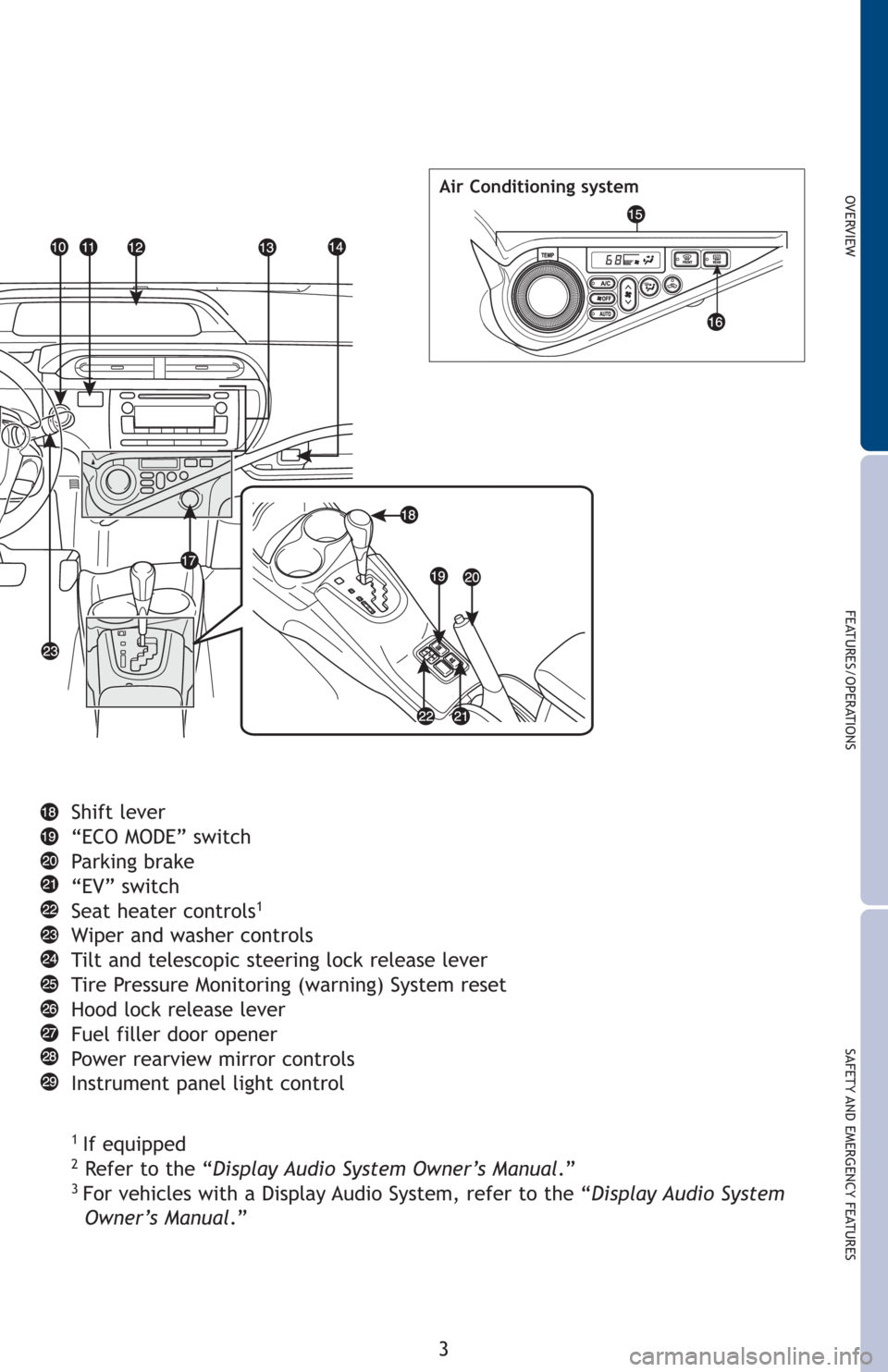
OVERVIEW
FEATURES/OPERATIONS
SAFETY AND EMERGENCY FEATURES
3
Air Conditioning system
Shift lever
“ECO MODE” switch
Parking brake
“EV” switch
Seat heater controls
1
Wiper and washer controls
Tilt and telescopic steering lock release lever
Tire Pressure Monitoring (warning) System reset
Hood lock release lever
Fuel filler door opener
Power rearview mirror controls
Instrument panel light control
1If equipped2Refer to the “Display Audio System Owner’s Manual.”3For vehicles with a Display Audio System, refer to the “Display Audio System
Owner’s Manual.”
Page 6 of 31
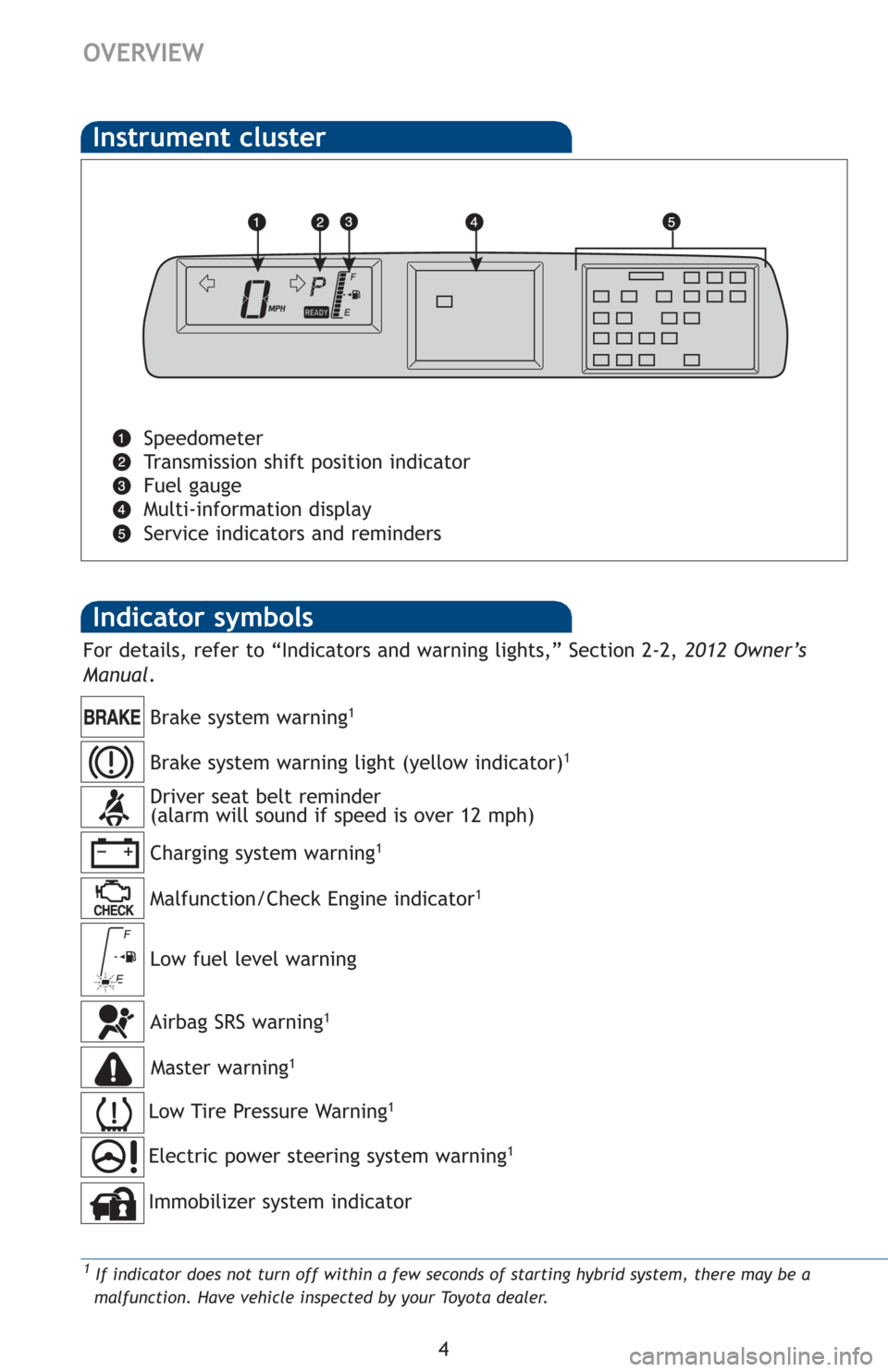
4
OVERVIEW
Indicator symbols
Instrument cluster
Speedometer
Transmission shift position indicator
Fuel gauge
Multi-information display
Service indicators and reminders
Charging system warning1
Brake system warning1
Low Tire Pressure Warning1
Immobilizer system indicator
Airbag SRS warning1
Master warning1
Driver seat belt reminder
(alarm will sound if speed is over 12 mph)
Malfunction/Check Engine indicator
1
Low fuel level warning
Electric power steering system warning1
Brake system warning light (yellow indicator)1
1
If indicator does not turn off within a few seconds of starting hybrid system, there may be a
malfunction. Have vehicle inspected by your Toyota dealer.
For details, refer to “Indicators and warning lights,” Section 2-2, 2012 Owner’s
Manual.
Page 7 of 31
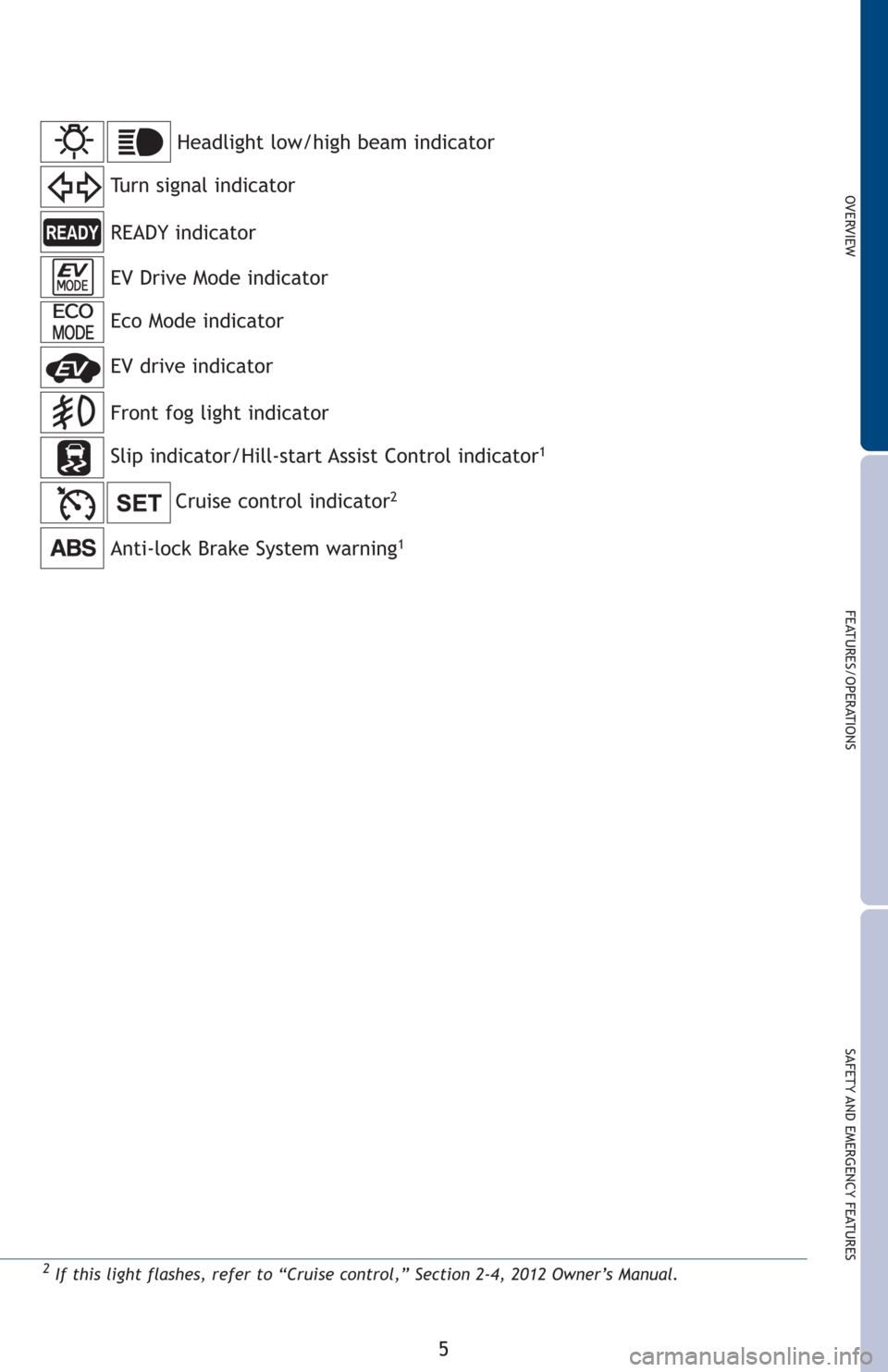
OVERVIEW
FEATURES/OPERATIONS
SAFETY AND EMERGENCY FEATURES
5
2If this light flashes, refer to “Cruise control,” Section 2-4, 2012 Owner’s Manual.
Anti-lock Brake System warning1
Headlight low/high beam indicator
Turn signal indicator
Slip indicator/Hill-start Assist Control indicator
1
Cruise control indicator2
READY indicator
Front fog light indicator
Eco Mode indicator
EV Drive Mode indicator
EV drive indicator
Page 9 of 31

OVERVIEW
FEATURES/OPERATIONS
SAFETY AND EMERGENCY FEATURES
7
Smart Key system (if equipped)
Start function
Accessories such as the radio will operate.
Power ON; hybrid system is not engaged.
All systems OFF.
ACCESSORY
ON
OFF
Push Depress
brake pedal
Carrying
Without depressing the brake pedal, pressing the “POWER” switch will change the
operation mode in succession from:
Power (without starting hybrid system)
* Driver door unlocking function can be programmed to unlock driver door only, or
all doors. Grasping passenger door handle will unlock all doors.
NOTE:Doors may also be locked/unlocked using remote.
Locking operation (if equipped)Unlocking operation (if equipped)
Carry remote to lock Carry remote to unlock
All-door lockDriver door unlock*
Back door lock/unlock (if equipped)
Carry remote to
lock/unlock
To u c hGrasp
Push to lockPush to unlock
Page 12 of 31
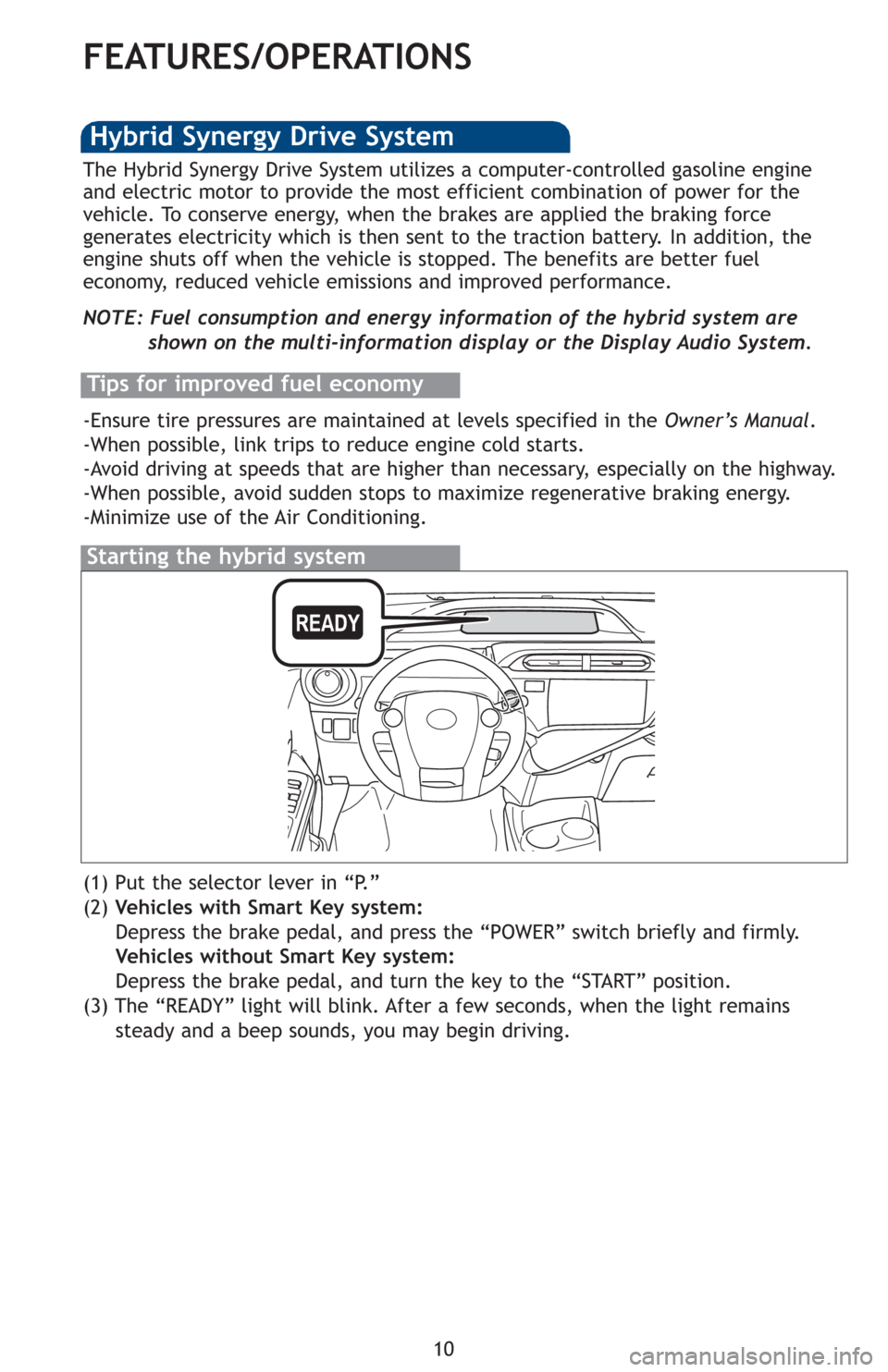
10
FEATURES/OPERATIONS
Starting the hybrid system
The Hybrid Synergy Drive System utilizes a computer-controlled gasoline engine
and electric motor to provide the most efficient combination of power for the
vehicle. To conserve energy, when the brakes are applied the braking force
generates electricity which is then sent to the traction battery. In addition, the
engine shuts off when the vehicle is stopped. The benefits are better fuel
economy, reduced vehicle emissions and improved performance.
NOTE: Fuel consumption and energy information of the hybrid system are
shown on the multi-information display or the Display Audio System.
Tips for improved fuel economy
-Ensure tire pressures are maintained at levels specified in the Owner’s Manual.
-When possible, link trips to reduce engine cold starts.
-Avoid driving at speeds that are higher than necessary, especially on the highway.
-When possible, avoid sudden stops to maximize regenerative braking energy.
-Minimize use of the Air Conditioning.
Hybrid Synergy Drive System
(1) Put the selector lever in “P.”
(2) Vehicles with Smart Key system:
Depress the brake pedal, and press the “POWER” switch briefly and firmly.
Vehicles without Smart Key system:
Depress the brake pedal, and turn the key to the “START” position.
(3) The “READY” light will blink. After a few seconds, when the light remains
steady and a beep sounds, you may begin driving.
Page 13 of 31
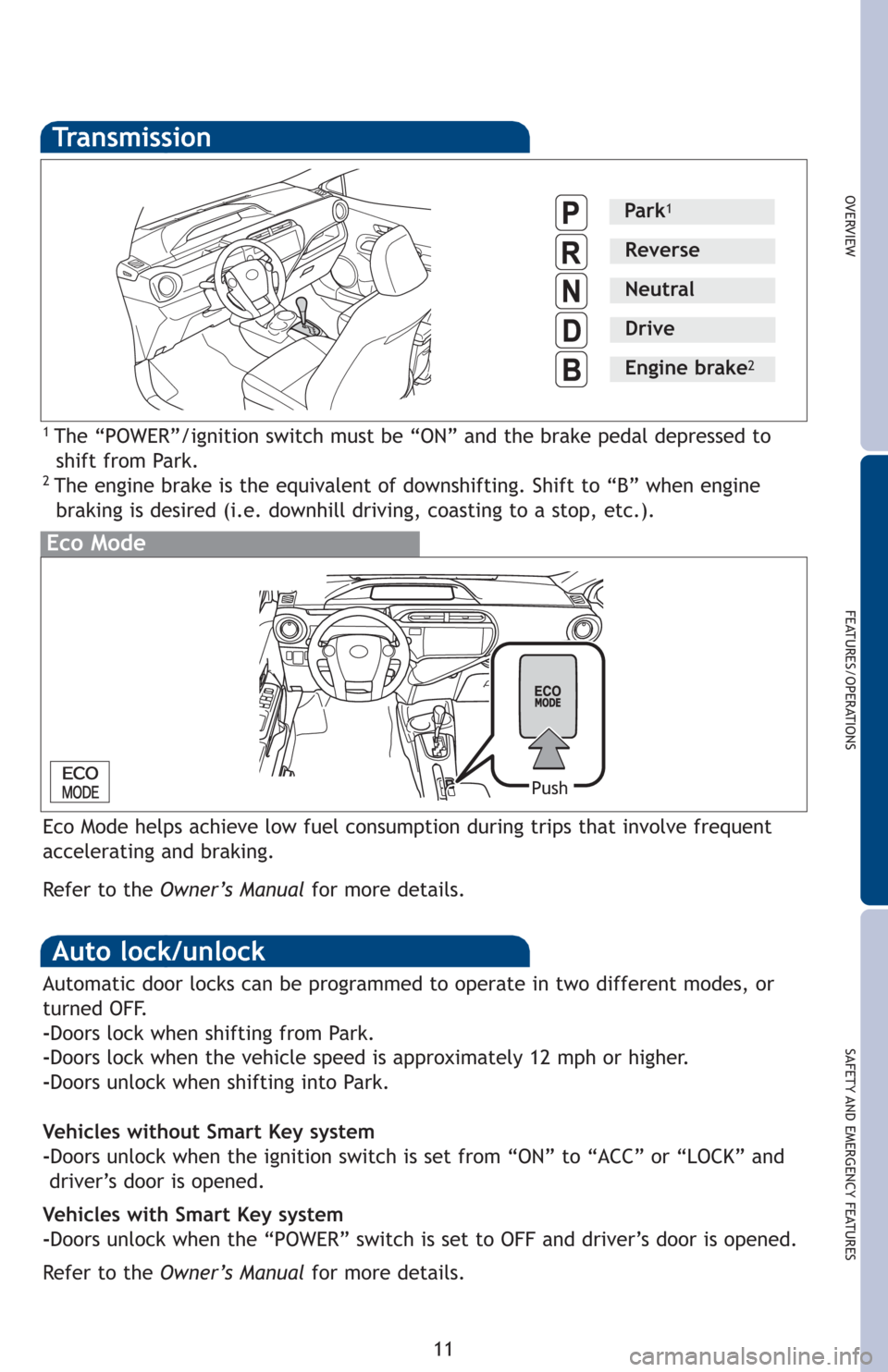
OVERVIEW
FEATURES/OPERATIONS
SAFETY AND EMERGENCY FEATURES
11
Transmission
1 The “POWER”/ignition switch must be “ON” and the brake pedal depressed to
shift from Park.
2 The engine brake is the equivalent of downshifting. Shift to “B” when engine
braking is desired (i.e. downhill driving, coasting to a stop, etc.).
Eco Mode
Push
Eco Mode helps achieve low fuel consumption during trips that involve frequent
accelerating and braking.
Refer to the Owner’s Manualfor more details.
Park1
Reverse
Neutral
Drive
Engine brake2
Auto lock/unlock
Automatic door locks can be programmed to operate in two different modes, or
turned OFF.
-Doors lock when shifting from Park.
-Doors lock when the vehicle speed is approximately 12 mph or higher.
-Doors unlock when shifting into Park.
Vehicles without Smart Key system
-Doors unlock when the ignition switch is set from “ON” to “ACC” or “LOCK” and
driver’s door is opened.
Vehicles with Smart Key system
-Doors unlock when the “POWER” switch is set to OFF and driver’s door is opened.
Refer to the Owner’s Manualfor more details.
Page 22 of 31
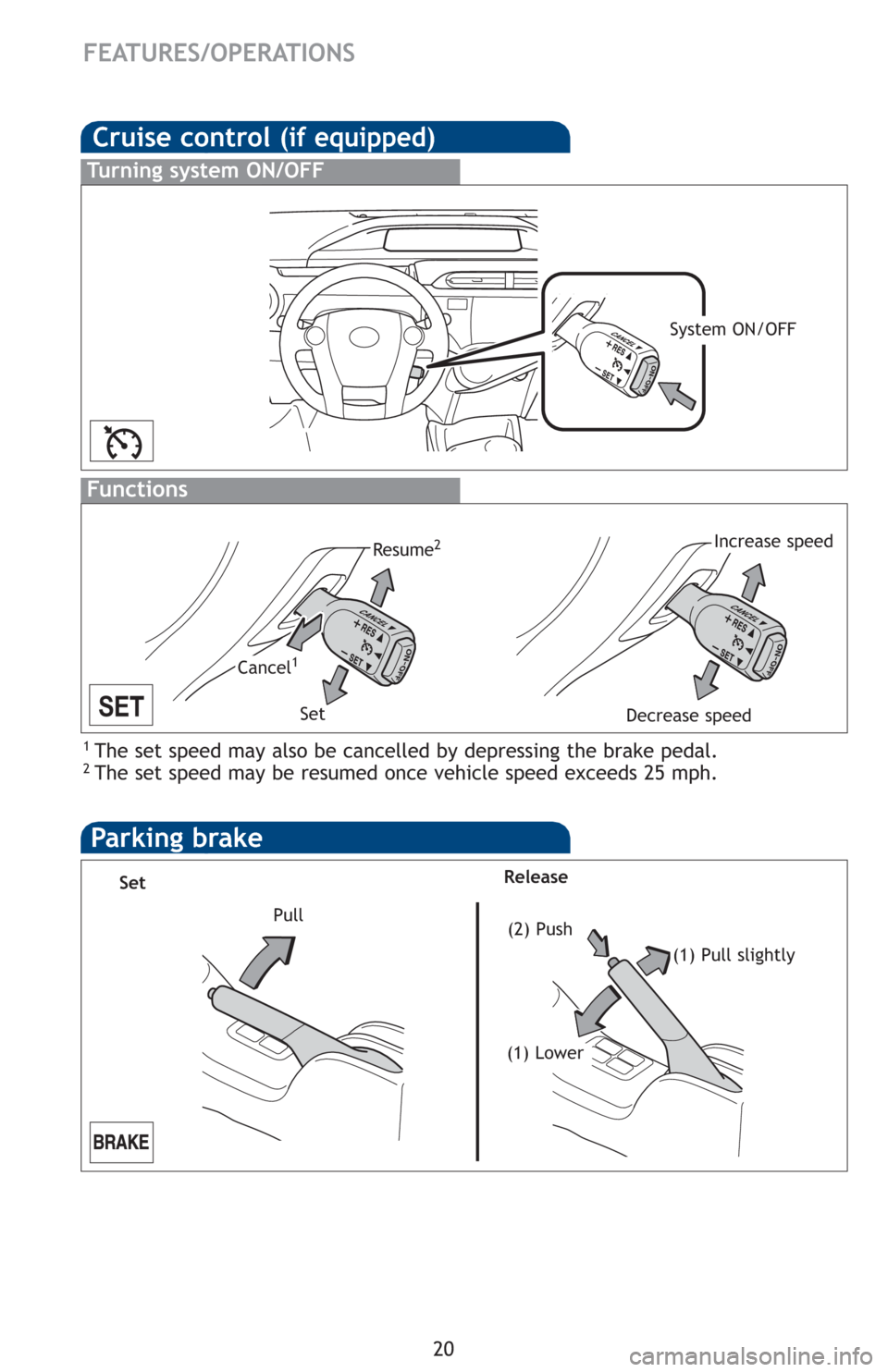
20
Cruise control (if equipped)
1 The set speed may also be cancelled by depressing the brake pedal.2 The set speed may be resumed once vehicle speed exceeds 25 mph.
Turning system ON/OFF
Functions
System ON/OFF
Increase speed
Decrease speed
Cancel1
Resume2
Set
FEATURES/OPERATIONS
Parking brake
SetRelease
Pull(2) Push
(1) Pull slightly
(1) Lower
Page 25 of 31
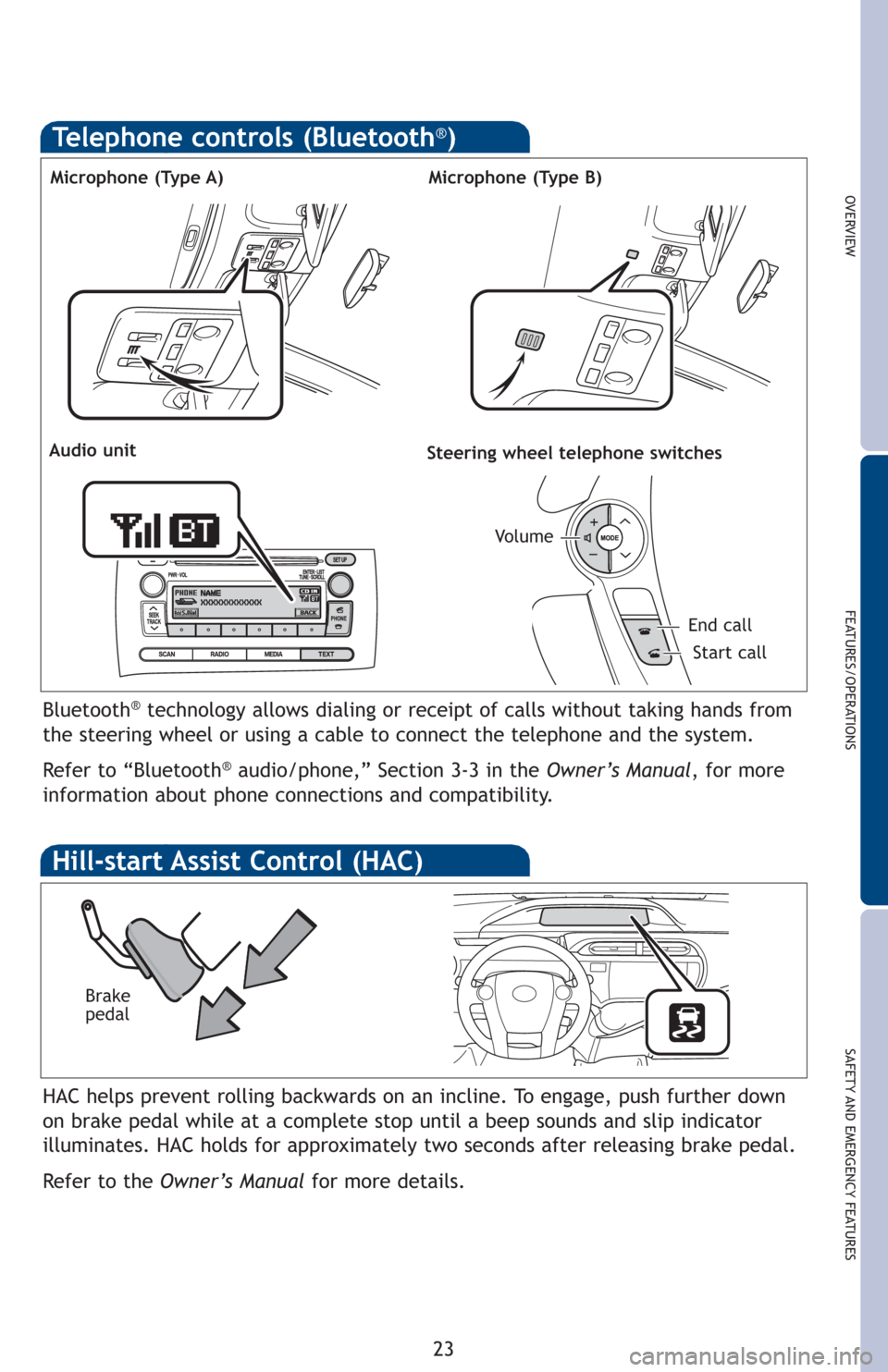
OVERVIEW
FEATURES/OPERATIONS
SAFETY AND EMERGENCY FEATURES
23
Bluetooth®technology allows dialing or receipt of calls without taking hands from
the steering wheel or using a cable to connect the telephone and the system.
Refer to “Bluetooth
®audio/phone,” Section 3-3 in the Owner’s Manual, for more
information about phone connections and compatibility.
Microphone (Type A)
Audio unitSteering wheel telephone switches
Vo l u m e
Start call
End call
Microphone (Type B)
HAC helps prevent rolling backwards on an incline. To engage, push further down
on brake pedal while at a complete stop until a beep sounds and slip indicator
illuminates. HAC holds for approximately two seconds after releasing brake pedal.
Refer to the Owner’s Manualfor more details.
Brake
pedal
Hill-start Assist Control (HAC)
Telephone controls (Bluetooth®)
Page 28 of 31
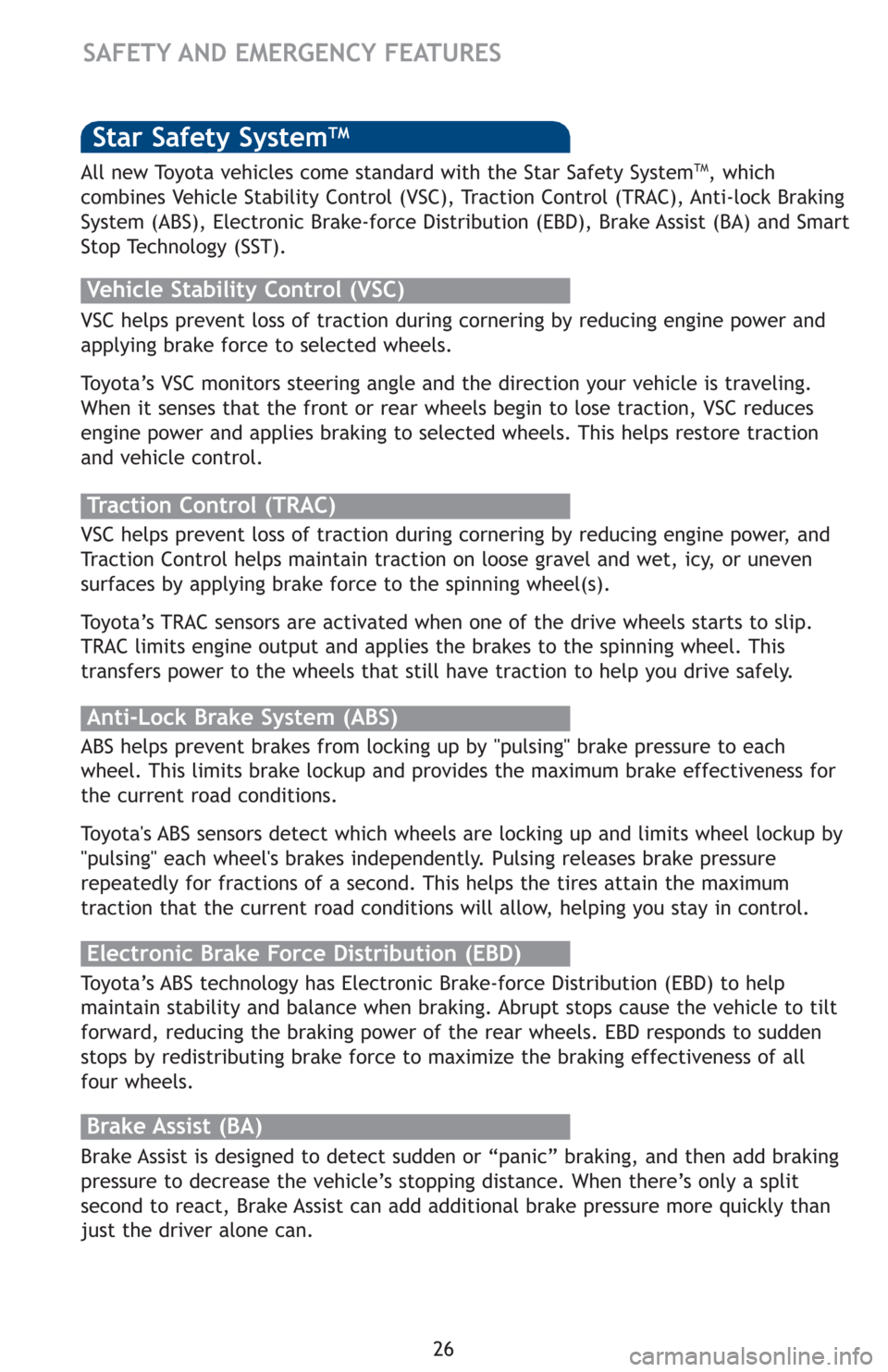
26
Star Safety SystemTM
VSC helps prevent loss of traction during cornering by reducing engine power and
applying brake force to selected wheels.
Toyota’s VSC monitors steering angle and the direction your vehicle is traveling.
When it senses that the front or rear wheels begin to lose traction, VSC reduces
engine power and applies braking to selected wheels. This helps restore traction
and vehicle control.
Vehicle Stability Control (VSC)
Anti-Lock Brake System (ABS)
Brake Assist (BA)
ABS helps prevent brakes from locking up by "pulsing" brake pressure to each
wheel. This limits brake lockup and provides the maximum brake effectiveness for
the current road conditions.
Toyota's ABS sensors detect which wheels are locking up and limits wheel lockup by
"pulsing" each wheel's brakes independently. Pulsing releases brake pressure
repeatedly for fractions of a second. This helps the tires attain the maximum
traction that the current road conditions will allow, helping you stay in control.
Brake Assist is designed to detect sudden or “panic” braking, and then add braking
pressure to decrease the vehicle’s stopping distance. When there’s only a split
second to react, Brake Assist can add additional brake pressure more quickly than
just the driver alone can. VSC helps prevent loss of traction during cornering by reducing engine power, and
Traction Control helps maintain traction on loose gravel and wet, icy, or uneven
surfaces by applying brake force to the spinning wheel(s).
Toyota’s TRAC sensors are activated when one of the drive wheels starts to slip.
TRAC limits engine output and applies the brakes to the spinning wheel. This
transfers power to the wheels that still have traction to help you drive safely.
Traction Control (TRAC)
Electronic Brake Force Distribution (EBD)
Toyota’s ABS technology has Electronic Brake-force Distribution (EBD) to help
maintain stability and balance when braking. Abrupt stops cause the vehicle to tilt
forward, reducing the braking power of the rear wheels. EBD responds to sudden
stops by redistributing brake force to maximize the braking effectiveness of all
four wheels.
SAFETY AND EMERGENCY FEATURES
All new Toyota vehicles come standard with the Star Safety SystemTM, which
combines Vehicle Stability Control (VSC), Traction Control (TRAC), Anti-lock Braking
System (ABS), Electronic Brake-force Distribution (EBD), Brake Assist (BA) and Smart
Stop Technology (SST).